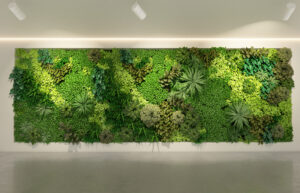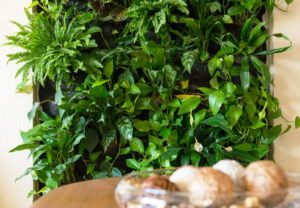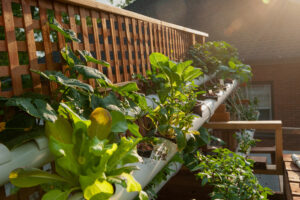The first time I saw a living green wall was in the Detroit Airport. I remember, despite a twelve-hour time difference, I found myself marveling at the beauty of this green wall. And once I discovered that green walls weren’t just for commercial buildings, but that I could have one in my house, I had to know more.
Can I have a green wall in my house?
Yes! As long as your house has stable walls–which it should be, if you’re living in it–you can transform any of its walls (or even a fence) into a green wall.
What kind of day-to-day commitment does a green wall require?
First off, this is not a houseplant you can forget for a month and it somehow still clings onto life. Green walls are high maintenance. The best thing you can do is to keep a chart of the frequency and intensity of your pruning and watering.
Most indoor green walls will only need to be watered once a week until the soil is not retaining any more of the water. Overwatering is the most common way indoor green walls die, so try to stick to one week intervals (or 5 days, minimum). It would also be a good moment to check for pests or if the plants need pruning. If at any point a plant begins to drape over or shade another plant, it is time to prune it. Try your best to write down when and which section of your green wall you pruned in your at-home log.
Green wall installation companies may offer to do this all for you, but you can choose for yourself.
Watering your live wall will be extremely difficult and pretty messy unless you install an irrigation system along with the frame. The irrigation system will do all the watering for you in an environmentally-friendly and cost-efficient way; it won’t overwater plants as it is on a time table based on your climate, soil, and plant life, and will therefore save both water and money.
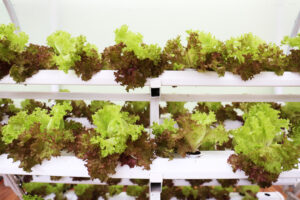
What will a green wall do for me and my household?
According to the EPA, Americans spend an average of 90% of their lives indoors. Ninety percent! This makes it even more important to bring the outdoors in and have good air quality indoors. And while you may be thinking that the indoors are not really known for their bad air quality, the EPA states that “indoor levels of pollutants may be two to five times — and occasionally more than 100 times — higher than outdoor levels.”
In a study conducted in 2019 entitled “Green Facades and Living Walls—Mapping the Benefits,” the positive impact of living walls on air pollution was examined. In every case, living walls were shown to reduce toxins and PM particles types significantly. PM particles–or “particulate matter pollution”–are found throughout the air and cause a range of health problems from irritated eyes to heart and lung disease.
Naturally, there is also an aesthetic appeal to a green wall. A green wall can have a fantastical fairy tale cottage vibe or bring in a sleek, contemporary ambience. The plants that make up a living wall add texture, color, and art all in one.
One of my favorite elements of having a green wall is you can truly make it your own. It can simply be a viney wall or a swirling, detailed pattern made from leaves and stems. No two green walls are the same.
Would a green wall decrease my energy bill?
Besides their aesthetic benefits, living walls, green walls, or vertical gardens have many energy benefits–from heating and cooling performance to air purification.
In this article, we have not gone into depth about the many different kinds of living walls that there are. Even still, there are several energy benefits that apply to green walls across the board.
In the same study that looked at PM particles, the researchers looked at thermal performance of several different types of living walls. Each type of living wall (except the one in a subtropical climate) was shown to cool its surrounding environment. Only about 1/7 of the walls helped heat the home in a significant way.
In other words, green walls in the summertime typically reduce residential living costs by 23%. How? Plants absorb approximately 34% of the sunlight that hits them–blocking that sunlight from overheating your home. You will notice that you will need less air conditioning, which will also be seen in your energy bill.
Okay, so a green wall will decrease my energy bill, but by how much?
You may notice that most of the pricing figures for a green wall are drawn up for commercial businesses who want a HUGE green wall. These prices will probably send you running for the hills.
Keep in mind that you are probably not considering a 500 square foot green wall installation. Instead, maybe 30 square feet of living wall–just a nice section in your living room–may be closer to what you want. While it depends on which installation company you go with, your irrigation system, and plant selection, living walls can cost anywhere between $125 and $250 per square foot. So for that 30 square feet space, the upfront cost could be anywhere between $3,750 and $7,500.
Additionally, there are ways to reduce the hydroponics bill. You might put your living wall in line of the most direct sunlight possible in your home to decrease the amount of artificial light required. Or you might collect rainwater/use recycled grey or black water. Since so much about the hydroponic electricity bill depends on the electricity cost, hour, and wattage, it is nice to know that there are a few things you can do to lower the bill no matter what.
Right now, if you installed a 30 square foot green wall at $125 for installation per square foot, it would take approximately 11 years for your savings to pay off the upfront cost, excluding any maintenance work that may come up in that time.
Is it harder to heat my house with a green wall since its cooling performance is so high?
Living walls are known for their fantastic cooling performance, which is great for the summer, but what about winter? Is it harder to heat your house with a green wall in it? It seems like the answer should be yes, especially considering that some plants emit heat (known as thermogenic plants). .
But the answer is actually no. A living wall helps to heat your home by providing another layer of natural insulation to retain precious heat. In fact, you should not even have to worry about accidentally choosing a thermogenic (or heat-releasing) plant as they are usually very large and/or not suitable for vertical growth.
Still, when compared to the cooling performance, the heating performance of a living wall is sorely lacking. According to the Vertiss modular model of a green wall produced in France, while their walls help reduce air conditioning costs by around 71%, heating costs are only reduced by about 4%. The average California energy bill per month is $101.49, with about 40% of that making up heating and cooling costs. So you could pay as little as $72.67 in the summer and $99.87 in the winter.
So while the benefits of a green wall in the summer are significant and undeniable, the winter benefits are minimal.
Finally–how does a green wall work?
There are two types of green walls: a hydroponic system and a substrate system. Each works in a different way.
The main difference is that a hydroponic system has a mineral fibre or a felt mat that the plants grow vertically into. It is the most common of the two.
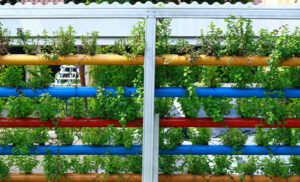
The substrate (or soil-based) system is more like a plant shelving wall, similar to bookshelves. These “shelves” are pockets of dirt and they allow the plants to grow on a horizontal plane, but still on your wall.
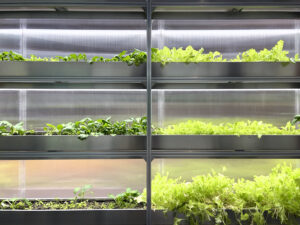
Other than these slight differences, living green walls are built similarly.
Every live green wall is made up of a few components: the wall/structure, the watering system (if you choose to have one), the growing medium layer, the base plant level with tropical flora, and the outer layer that is made up of plants native to your climate.
Since nearly all walls in the average home can hold soil and plants (unlike how most roofs can not hold a green roof), most installations will require a frame that attaches to the wall. Additionally, if you install an irrigation system, a waterproof barrier will be put into place to protect the wall’s integrity.
The irrigation system is one of the coolest components of a vertical garden. Most green walls use a drip-irrigation system which decreases water waste. As the name suggests, water drips down to the roots of the plants slowly, giving the plants enough time to absorb water while also avoiding over-watering.
An alternative to the drip-irrigation system is the recirculation system which pumps water from the bottom to the top repeatedly until no water remains. Where the drip-irrigation system minimizes water waste, the recirculation system is far more efficient energy-wise.
Of course, if there is no room for a tank or you don’t want to pay for an irrigation system–and feel you are up to the task–you may always opt for direct irrigation (using a watering can or hose).
Lastly, depending on where you choose to install the living green wall, an artificial light source may be necessary to keep the plants thriving.
Conclusion
Hydroponics, green walls, and everything in between are still in the early stages of development, especially when it comes to a small-scale residential green wall application. It is pretty costly now, and many pricing figures are unknown.
As time goes on and the technology improves, the green wall in a residential setting will only get more efficient, both in energy usage and cost. Right now, despite the unknown, there is no doubt that a green wall is aesthetically pleasing, will save you money on your energy bill, and provides a large range of health benefits. But you must weigh the pros and cons for yourself.
References
https://www.epa.gov/report-environment/indoor-air-quality#note1
https://www.mdpi.com/2071-1050/11
https://www.asla.org/residentialgreenwalls.aspx
https://www.britannica.com/science/photosynthesis/Energy-efficiency-of-photosynthesis
https://www.vertiss.net/des-villes-plus-vertes?lang=en
https://greenroofs.org/about-green-walls
https://thehydroponicsplanet.com/how-much-electricity-does-hydroponics-use/
